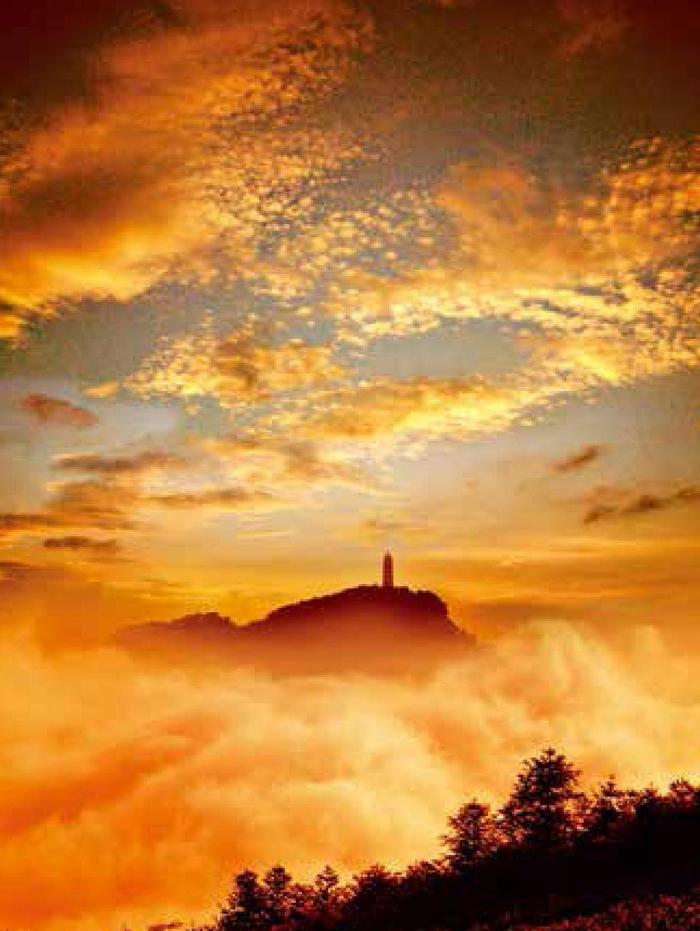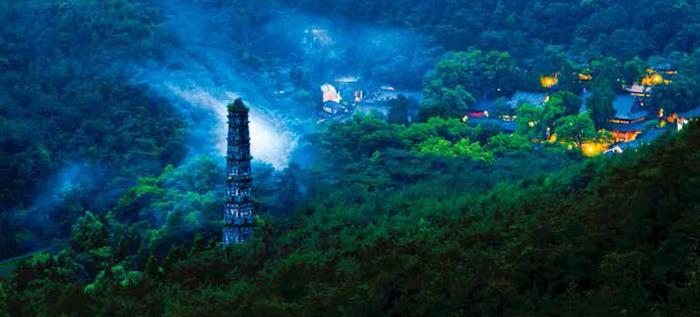唐诗的栖息地
2020-12-28张青春
张青春



在唐代,天台山因其山岳之神秀和人文渊源之独特而成为当时人眼中的“诗和远方”。
当时,前往天台山的有一个诗人群体,他们从长安出发至扬州,然后循着大运河,跨钱塘江,经浙东运河,沿曹娥江和剡溪,终至天台山,这就是因天台山这个目的地而产生的唐诗之路。
这个诗人群体,是一个不折不扣的江湖。既有春风得意的朝廷大员,如曾两度拜相的李德裕、台州刺史郑薰、浙东观察使元稹,也有仕途失意,来此遣怀的李白和孟浩然,还有炼丹方士柳泌,工于诗而无功名之念的周朴;既有归隐山林的隐士,如徐凝、陈寡言和刘长卿等,也有早年为僧后来还俗的贾岛和周贺,或初为道士后来科考的曹唐,也有真正的得道高僧,如皎然等。此外,还有未至天台山,但是凭想象书写天台山的唐明皇李隆基,天台山本地高僧拾得和寒山等人。他们留下的关于天台山的诗歌中,天台山的魅力山水、佛道文化都是反复出现的主题,这些描写和叙述,为今人了解当时的天台山提供了重要的证据,也为今天的天台山注入了文学的魅力。
望 海
天台山景色的绮丽雄奇,吸引着唐朝诗人们来此遣兴抒怀。孟浩然在《自洛之越》中说:“山水寻吴越”“欲寻华顶去”;李郢更是直接,在《重游天台》中写道:“南国天台山水奇。”除了提到天台山,诗人们也專门描写石梁飞瀑、华顶峰、国清寺、赤城山、灵溪、桃源洞、桐柏观、玉霄山、琼台双阙和寒岩等地。
从天台山可以望海,拥有雄奇丰富想象力的李白看到了“云垂大鹏翻,波动巨鳌没。风潮争汹涌,神怪何翕忽”,而善于描写现实的杜荀鹤则看到了“共僧岩上坐,见客海边行。野色人耕破,山根浪打鸣”。由山看海也有技巧,诗僧皎然指点朋友重钧上人,认为云彩正在消失之际最适合看海,即“海容云正尽”;而看山景则宜在雨过天晴之时,正所谓“山色雨初晴”。
天台山的高度也是诗人们描写的对象,最有名的莫过于李白的“天台四万八千丈,对此欲倒东南倾”了。蔡希逸对此作了更夸张的描写:“山上天将近,人间路渐遥。”意思是,天台山与天相接,离人间太远了。章八元的诗句“八重岩崿叠晴空,九色烟霞绕洞宫”,除了描写天台山的高,“九色烟霞”也描写了天台山的幽奇之美。华顶峰是天台山最高峰,四周群山向而拱之,层层相裹,状如百叶莲花,华顶正当花之顶,故名“华顶”,诗僧寒山闲游华顶峰,有“四顾晴空里,白云同鹤飞”的描述。
赏 瀑
天台山各处的瀑布尽显水的奇趣。
一是天台山大瀑布,曹松专门写了《天台瀑布》一诗,其中“喷向林梢成夏雪,倾来石上作春雷”,用夏雪和春雷形象地描写了天台山大瀑布的颜色和声势,让人如见其景,如闻其声。
第二是石梁瀑布,集奇石瀑布为一体,为诗人们所向往,蔡希逸诗“谁当云里见,知欲渡仙桥”极言其高,而李郢“石桥危险古来知”则极言其险。寒山诗中,“瀑布千丈流,如铺练一条。下有栖心窟,横安定命桥”,夸张地描写了石桥和飞瀑。另外,刘昭禹描写灵溪瀑布的“云开孤月上,瀑喷一山寒”一句也颇有气势。
除了瀑布,就是映带左右的溪水。徐凝在夜晚的月色中独自在山中行走,听到“石梁夜溪声”。桐柏山中的灵溪也在唐诗中时有提及,许浑的诗句“山多水不穷,一叶似渔翁。鸟浴寒潭雨,猿吟暮岭风”,非常写实地描写了灵溪的景色。
佛教的“天台宗”和道教的“南宗”都创于天台山,智者大师曾在天台山修行,创天台宗,桐柏山桐柏观是道教南宗所在地。
在隋唐时代,天台宗和桐柏观都极受统治者重视,隋代皇帝曾多次请智顗(yi)大师出山传戒。唐代几任皇帝多次接见道士司马承祯,佛教和道教在隋唐时代的地位可见一斑。另外,诗人贾岛和周贺曾为僧人,诗人曹唐曾是道士,可见当时佛教、道教的普及程度。佛道文化是天台山诗歌中以各种形式反复出现的主题,也就不奇怪了。
诗人们追求道家的长生和成仙。孟浩然在诗中说,“纷吾远游意,乐彼长生道”;李白则想“攀条摘朱实,服药炼金骨。安得生羽毛,千春卧蓬阙?”希冀通过服药炼骨,得道而飞升成仙。
另外,很多诗歌在标题和内容里出现或僧或道的人名,如皎然的《送重钧上人游天台》,张祜的《忆游天台寄道流》,贾岛《送僧归天台》,许浑《早发中岩寺别契直上人》,李隆基《王屋山送道士司马承祯还天台》,方干《赠天台叶尊师》,这些诗在标题中就有了或僧或道的名字。
在诗歌的内容里,孟浩然在《寻天台山》中提到“吾友太乙子”,李郢《重游天台》有“谁见生公独坐时”,贾岛《送僧归天台》有“应齐智者踪”,孟浩然《宿天台桐柏观》有“玄踪得二老”句。这不但说明当时文人和僧人道人的交往比较密切,同时也表明佛道文化深入其心。
诗人们游览天台山的寺庙道观,也写出了很多语言优美、引人遐思的诗歌。皎然是僧人,从他写的《宿桐柏观》可以推测,僧人夜宿道观,且对道观仙风道骨、圣地仙境气象予以肯定,说明了当时天台山佛道共融双栖的状况。国清寺依据天台宗创始人智顗亲手所画的样式所建,初名天台寺,因此诗中普遍将国清寺和天台寺共称。刘长卿在《送台州李使君,兼寄题国清寺》中称其为“应真飞锡处”;贾岛在《送僧归国清寺》中,赞其为“妙宇”(“妙宇研磨讲”);周贺用“杯度寺”代称国清寺(“一宿五峰杯度寺”)。天台寺及其周边的优美景色也深深地吸引了诗人们,国清寺前的十里松林几乎成了国清寺的标志,如李白用一贯的夸张手法写道:“五峰转月色,百里行松声”,贾岛用“石涧双流水,山门九里松”对此作了概括,专门提到了国清寺山门两侧的溪水,皮日休也有“十里松门国清路,饭猿台上菩提树”的句子。天台寺的景色给诗人带来了闲情逸致,杜荀鹤写道:“一到天台寺,高低景旋生。共僧岩上坐,见客海边行。野色人耕破,山根浪打鸣。忙时向闲处,不觉有闲情。”其夜景也让士子的心安静下来,如刘昭禹写道,“天台山下寺,冬暮景如屏。树密风长在,年深像有灵。高钟疑到月,远烧欲连星。因共真僧话,心中万虑宁。”有时国清寺的景色也给游子带来故园之思,如周贺写道“幽鸟背泉栖静境,远人当烛想遗文。暂来此地歇劳足,望断故山沧海濆(fén)。”
天台山是道教圣地,加上唐代道教最受重视,道教的影响在描写天台山的唐诗中俯拾皆是,经常出现的有桐柏观、灵溪观等。唐明皇送司马承祯归天台,称桐柏观为紫府,称司马承祯为“贤士”“逸人”和“幽栖者”。孟浩然曾造访桐柏观,诗中写道:“息阴憩桐柏,采秀弄芝草。鹤唳清露垂,鸡鸣信潮早。愿言解缨络,从此去烦恼。高步陵四明,玄踪得二老”。其中“芝草”“鹤唳”“去烦恼”,充满了道家的意象,“二老”即老子和老莱子,是道教祖师,都活了100多岁,孟浩然非常羡慕二人的长寿之道。周朴描写的桐柏观就更有动感,“东南一境清心目,有此千峰插翠微。人在下方冲月上,鹤从高处破烟飞。岩深水落寒侵骨,门静花开色照衣。欲识蓬莱今便是,更于何处学忘机”。写桐柏观清人心目、千峰翠微、冲月而上、破烟鹤飞,岩深水落、水寒侵骨,门静花开、花光照衣,将桐柏观的高旷、雄浑、深邃、幽静描绘的无以复加。郑薰带着一家人游览桐柏观,写出了“数里踏红叶,全家穿白云”的诗句,和周朴的描写有异曲同工之妙。
除了描绘山水和记录文化,天台山唐诗还忠实地记录了当时天台山的物产、传说和当时隐居者的生活,具有一定的史料价值,读来别有兴味。李敬方在《天台晴望》中写道:“林果黄梅尽,山苗半夏新”,这说明当时黄梅和半夏都是天台山的重要物產。多位诗人还提到琪树,如李绅专门写诗,表达了对琪树的喜爱之情,诗人的描写非常认真,不像是在作伪,可能真有这种树存在。陆龟蒙和李德裕则专门写诗描绘华顶杖和金松。另外,刘晨阮肇遇仙的浪漫传说多次出现在诗中,元稹在《桃源洞》诗中发问:“桃花飞尽东风起,何处消沉去不来?”桃花飞尽,不见仙人,为这首诗增添了理趣。诗人曹唐写了组诗,再现了神人恋爱、悲欢离合之全过程,使神话更为优美,诗句“洞里有天春寂寞,人间无路月茫茫”“桃花流水依然在,不见当时劝酒人”,读来让人荡气回肠,为之感叹。另外,陈寡言、徐凝和刘长卿的诗歌反映了当时隐士的生活风貌,陈寡言诗《玉霄山居》云:“醉卧茅堂不闭关,觉来开眼见青山。松花落处宿猿在,麋鹿群群林际还”,描述了隐居者悠然的生活。
阅读唐人天台山诗歌,有种梦回唐朝的穿越感,仿佛在和诗人一起在天台寺的灯光下阅读,一起看石梁飞瀑,一起穿云踏叶而来,一起看琪树飞花,一起走过十里松林大道,一起和他们追寻长生之道。唐代诗人在天台山游历和生活的风貌,都在这些诗中记录了下来。天台山的美丽和神圣在唐诗中有了一个诗意的栖息地,唐诗也因其文学地位为天台山增添了光彩,从而使天台山深深地刻上了唐诗的烙印。天台山的美和唐诗的美互相映照,相得益彰。今人如果不读天台山唐诗,借古人之眼来看天台山,则难尽其妙,因为每个山峰,每个洞穴,每个瀑布,每棵树木,不是死物,而是有文化传承的。
In as early as the Tang Dynasty, Mt. Tiantai already enjoyed an established fame for its holy mystery and epic beauty as well as its rich cultural connotation. In the eye of the romanticists at that time, the mist-wrapped mountaintop was the Elysium.
Among the mountains admirers were many poets who set off from Changan, the capital city of Tang, on a long journey that took them to Yangzhou and many places along the Grand Canal and eventually into the mountainous vistas of the Tiantai area. The route is romanticized by cultural scholars today as the “Road of Tang Poetry”.
The long list of Mt. Tiantais fans during the Tang Dynasty includes Li Bai, Meng Haoran, Jia Dao, Zhou He, etc. There were also lesser-known names such as Xu Ning, Chen Guayan, Liu Changqing, Cao Tang, just to name a few. Li Longji, Emperor Xuanzong of Tang, never got a chance to actually visit the mountain, but he released his yearning for the wonderland by extolling the gorgeous scenery out of his imagination. The mountains religious elements are also mentioned a lot in the Tang poems.
In one of his poems, Meng Haoran ranked the Huading Peak of Mt. Tiantai as the finest in the natural landscapes of the Jiangnan regions. Li Ying, a late Tang poet, had no mood for understatement in his . “The mountains and rivers in Tiantai are second to none,” he concluded.
As Mount Tiantai is near the sea, the scenic magnificence of the mountain area naturally includes the beauty of the sea, which appealed to the Tang romanticists and gave them lots of inspiration. “Sea” is mentioned in many poems of the Tang, either in a purely romantic tone by Li Bai or in a more realistic manner by Du Xunhe. Monk Jiaoran even shared his theory with his friend about the right timing of capturing the most beautiful moments of the sea. The best time to admire the seascape is when the sunset glow is fading, he advised.
The sheer height of the mountain impressed Li Bai and Cai Xiyi, the latter “complaining” that “the mountain is so close to the heaven that it is too elusive for earthly existence”.
The mountain area is strewn with cascading waterfalls in varying styles. Cao Songs describes the colors of the waterfall spectacle as the summer snow and compares the power of the waterfalls with spring thunders. The mountains waterfall vista is represented by the scenery in Shiliang, where the waters are set in an awe-inspiring backdrop of a weather-beaten stone bridge built treacherously in between two cliffs.
In sharp contrast to the ghostly waterfalls and cloud-clad cliffs is babbling crooks streaming down valleys and meandering in the depths of forests. It is easy to imagine how the poet Xu Ning was carried away when taking a random walk in breathtakingly beautiful scenery under the moonlight. “Beautiful waters are everywhere,” Xu Hun wrote in his poem that vividly describes the mesmerizing beauty of the Lingxi River in the Tongbai Mountain, part of Mount Tiantai region.
Mt. Tiantai is the birthplace of the Tiantai sect of Buddhism and the South sect of Taoism, with the core doctrines put together by Master Monk Zhizhe in his years living up in the mountain. Jia Dao and Zhou He, both known for their poetry, were also reverent monks. Buddhism and Taoism is therefore a very important theme in the “Tiantai poetry” of Tang. In many poems depicting the landscapes of Tiantai, readers today can find many clues suggesting the friendship and interaction between the Tang men of letters and religious people.
Poems about Tiantai also show the poets were enchanted by the architectural charm in the mountain area. The Guoqing Temple, together with the dainty grace of its surroundings, was an endless source of inspiration to poets. The pine forests that stretched miles in front of the main entrance of the temple made their way into poems by Li Bai, Jia Dao and many others. The nocturnal tranquility and mystic atmosphere enriched by the moonlight filled the heart of Liu Shaoyu with enormous solace and soft sentiment. “The wind sweeps across the dense leaves, as if a celestial being is wandering around...and all the anxieties in me disappear...” he wrote.
Taoism is an important part of the “Tiantai poetry” of Tang, as can be seen in the poems by Meng Haoran, Zhou Pu, and Zheng Xun.
The Tang poems are valuable materials for people today to take a peek into the social habits and custom, fauna and flora, and local specialties of the Tiantai region. In many poems, the lifestyle of the hermits living in Tiantai in the Tang period is vividly recorded.
In a word, the Tang period of China saw the majestic beauty of the mountains in Tiantai meet its ideal literary match, as if this ethereal world and the Tang romanticism were made just for each other.
